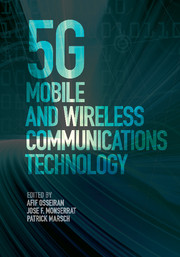Book contents
- Frontmatter
- Dedication
- Contents
- List of contributors
- Foreword
- Acknowledgments
- Acronyms
- 1 Introduction
- 2 5G use cases and system concept
- 3 The 5G architecture
- 4 Machine-type communications
- 5 Device-to-device (D2D) communications
- 6 Millimeter wave communications
- 7 The 5G radio-access technologies
- 8 Massive multiple-input multiple-output (MIMO) systems
- 9 Coordinated multi-point transmission in 5G
- 10 Relaying and wireless network coding
- 11 Interference management, mobility management, and dynamic reconfiguration
- 12 Spectrum
- 13 The 5G wireless propagation channel models
- 14 Simulation methodology
- Index
- References
7 - The 5G radio-access technologies
Published online by Cambridge University Press: 05 June 2016
- Frontmatter
- Dedication
- Contents
- List of contributors
- Foreword
- Acknowledgments
- Acronyms
- 1 Introduction
- 2 5G use cases and system concept
- 3 The 5G architecture
- 4 Machine-type communications
- 5 Device-to-device (D2D) communications
- 6 Millimeter wave communications
- 7 The 5G radio-access technologies
- 8 Massive multiple-input multiple-output (MIMO) systems
- 9 Coordinated multi-point transmission in 5G
- 10 Relaying and wireless network coding
- 11 Interference management, mobility management, and dynamic reconfiguration
- 12 Spectrum
- 13 The 5G wireless propagation channel models
- 14 Simulation methodology
- Index
- References
Summary
The radio access for 5G will have to respond to a number of diverse requirements raised by a large variety of different new services, such as those from the context of massive Machine-Type Communication (mMTC) and ultra-reliable MTC (uMTC), as discussed in Chapter 2. Consequently, a “one-size-fits-all” solution for the air interface as prevalent in today's radio systems may no longer be the adequate choice in the future, as it can merely provide an inadequate compromise. Instead, the system should provide more flexibility and scalability to enable tailoring the system configurations to the service types and their demands. Moreover, as the data rates to be provided by mobile radio systems are ever increasing, technologies need to be devised to squeeze out the last bit from the scarce spectrum resources. This chapter elaborates on novel radio-access technologies addressing the aforementioned issues, which can be considered promising candidates for the 5G system. It is noteworthy that there has been flourishing work on potential radio-access technologies for 5G in recent time; refer to [1][2] for prominent research activities in the field.
The chapter starts with a general introduction to the access design principles for multi-user communications in Section 7.1, which build the fundamentals for the novel access technologies presented in this chapter. Section 7.2 then presents novel multi-carrier waveforms based on filtering, which offer additional degrees of freedom in the system design to enable flexible system configurations. Novel non-orthogonal multiple-access schemes yielding an increased spectral efficiency are presented in Section 7.3. The following three sections then elaborate on radio access technologies and scalable solutions tailored for specific use cases, which are considered key drivers for 5G radio systems. Section 7.4 focuses on Ultra-Dense Networks (UDN), where also higher frequencies beyond 6 GHz are expected to be used. Section 7.5 presents an ad-hoc radio-access solution for the Vehicle-to-Anything (V2X) context, and finally Section 7.6 proposes schemes for the massive access of Machine-Type Communication (MTC) devices, characterized by a low amount of overhead and thus enabling an energy efficient transmission.
Table 7.1 gives a brief overview on the radio-access technologies presented in this chapter, highlighting some of their characteristics and properties. It should be noted that the gathered information is not exhaustive and only the most important aspects are listed.
- Type
- Chapter
- Information
- 5G Mobile and Wireless Communications Technology , pp. 158 - 207Publisher: Cambridge University PressPrint publication year: 2016
References
- 1
- Cited by



